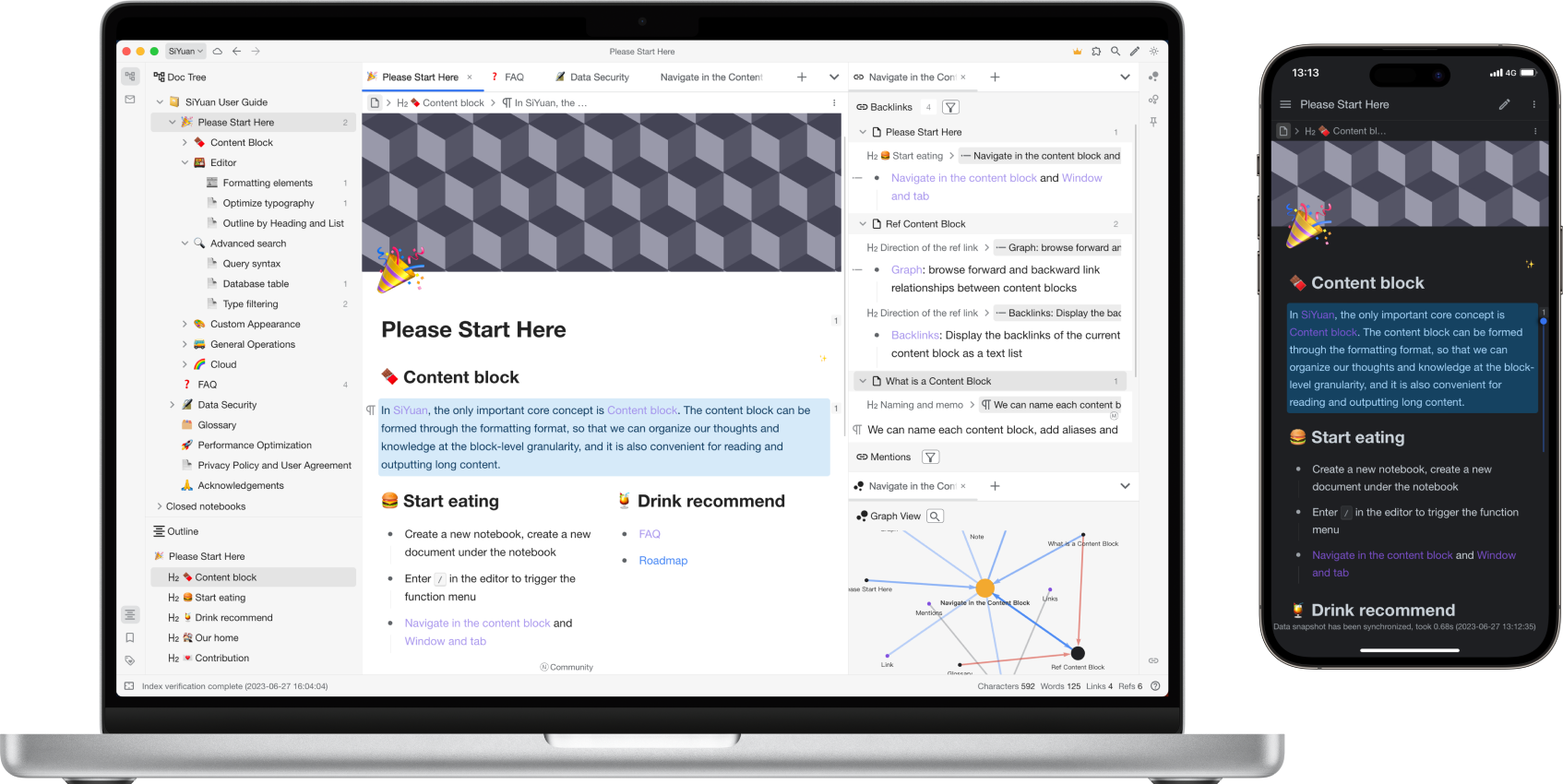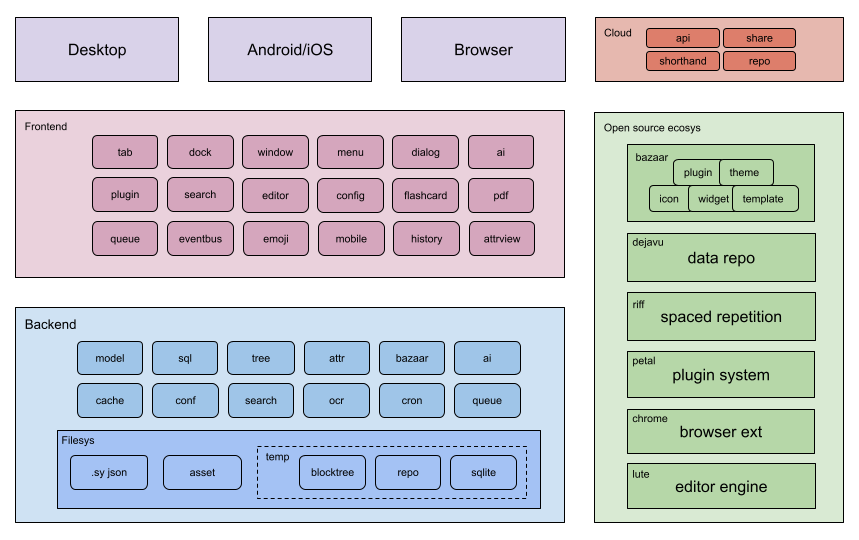SiYuan is a privacy-first personal knowledge management system, support fine-grained block-level reference and Markdown WYSIWYG.
Welcome to SiYuan English Discussion Forum to learn more.
Most features are free, even for commercial use.
- Content block
- Block-level reference and two-way links
- Custom attributes
- SQL query embed
- Protocol
siyuan://
- Editor
- Block-style
- Markdown WYSIWYG
- List outline
- Block zoom-in
- Block horizontal layout
- Million-word large document editing
- Mathematical formulas, charts, flowcharts, Gantt charts, timing charts, staffs, etc.
- Web clipping
- PDF Annotation link
- Export
- Block ref and embed
- Standard Markdown with assets
- PDF, Word and HTML
- Copy to WeChat MP, Zhihu and Yuque
- Spaced repetition
- Multi-tab, drag and drop to split screen
- Template snippet
- JavaScript/CSS snippet
- Android/iOS APP
- Docker deployment
- API
- Community marketplace
Some features are only available to paid members, for more details please refer to Pricing.
- bazzar: Community marketplace
- dejavu: Data repo
- riff: Spaced repetition system
- petal: Plugin API
- chrome: Chrome extension
- lute: A structured editor engine that supports Go and JavaScript
- ios: iOS APP
- android: Android APP
It is recommended to give priority to installing through the application market on the desktop and mobile, so that you can upgrade the version with one click in the future.
Docker Deployment
The easiest way to serve SiYuan on a server is to deploy it through Docker.
- Image name
b3log/siyuan - Image URL
The overall program is located under /opt/siyuan/, which is basically the structure under the resources folder of the Electron installation package:
- appearance: icon, theme, languages
- guide: user guide document
- stage: interface and static resources
- kernel: kernel program
The entry point is set when building the Docker image: ENTRYPOINT ["/opt/siyuan/kernel" ], use docker run b3log/siyuan with parameters to start:
--workspacespecifies the workspace folder path, mounted to the container via-von the host
More parameters can refer to --help. The following is an example of a startup command: docker run -v workspace_dir_host:workspace_dir_container -p 6806:6806 b3log/siyuan --workspace=workspace_dir_container
workspace_dir_host: the workspace folder path on the hostworkspace_dir_container: The path of the workspace folder in the container, which is the same as specified in--workspace
To simplify, it is recommended to configure the workspace folder path to be consistent on the host and container, such as: workspace_dir_host and workspace_dir_container are configured as /siyuan/workspace, the corresponding startup commands is: docker run -v /siyuan/workspace:/siyuan/workspace -p 6806:6806 -u 1000:1000 b3log/siyuan --workspace=/siyuan/workspace/.
In the image, the normal user siyuan (uid 1000/gid 1000) created by default is used to start the kernel process. Therefore, when the host creates a workspace folder, please pay attention to setting the user group of the folder: chown -R 1000:1000 /siyuan/workspace. The parameter -u 1000:1000 is required when starting the container.
Hidden port
Use NGINX reverse proxy to hide port 6806, please note:
- Configure WebSocket reverse proxy
/ws
- Be sure to confirm the correctness of the mounted volume, otherwise the data will be lost after the container is deleted
- Do not use URL rewriting for redirection, otherwise there may be problems with authentication, it is recommended to configure a reverse proxy
- Does not support desktop and mobile application connections, only supports use on browsers
- Export to PDF, HTML and Word formats is not supported
- Import Markdown file is not supported
We release insider preview before major updates, please visit https://github.com/siyuan-note/insider.
See Development Guide.
The data is saved in the workspace folder, in the workspace data folder:
assetsis used to save all inserted assetsemojisis used to save emoji imagessnippetsis used to save code snippetsstorageis used to save query conditions, layouts and flashcards, etc.templatesis used to save template snippetswidgetsis used to save widgetspluginsis used to save pluginspublicis used to save public data- The rest of the folders are the notebook folders created by the user, files with the suffix of
.syin the notebook folder are used to save the document data, and the data format is JSON
Data synchronization through third-party synchronization disks is not supported, otherwise data may be corrupted.
Although it does not support third-party sync disks, it supports connect with third-party cloud storage (Member's privileges).
In addition, you can also consider manually exporting and importing data to achieve data synchronization:
- Desktop: Settings - Export - Export Data / Import Data
- Mobile: Right column - About - Export Data / Import Data
SiYuan is completely open source, and contributions are welcome:
For more details, please refer to Development Guide.
- If installed via app store, please update via app store
- If it is installed through the installation package on the desktop, you can open the option of Settings - About - Automatically download update installation package, so that SiYuan will automatically download The latest version of the installation package and prompts to install
- If it is installed by manual installation package, please download the installation package again to install
You can Check update in Settings - About - Current Version, or pay attention to Official website or [GitHub Releases](https ://github.com/siyuan-note/siyuan/releases) to get the new version.
After deletion, the doc will not appear in the operating system's recycle bin, but will be deleted directly. When deleted, SiYuan will generate data history.
Please use Shift+Enter.
The first sub-block under the list item is the block icon omitted. You can move the cursor into this block and trigger its block menu with Ctrl+/ .
- Share document to Liandi
- Export and import
.sy.zippackage - Via network hosting
- Export and import Markdown
- Export Preview to copy to third-party online services
-
If the data repo key is correctly initialized on multiple devices before, the key is the same on all devices and can be set in Settings - About - Data repo key - Copy key string retrieve
-
If it has not been configured correctly before (for example, the keys on multiple devices are inconsistent) or all devices are unavailable and the key string cannot be obtained, you can reset the key by following the steps below:
- Manually back up the data, you can use Export Data or directly copy the workspace/data/ folder on the file system
- Settings - About - Data rep key - Reset data repo
- Reinitialize the data repo key. After initializing the key on one device, other devices import the key
- The cloud uses the new synchronization directory, the old synchronization directory is no longer available and can be deleted
- The existing cloud snapshots are no longer available and can be deleted
Most features are free, even for commercial use.
Member's privileges can only be used after payment, please refer to Pricing.
The birth of SiYuan is inseparable from many open source projects and contributors, please refer to the project source code/kernel/go.mod, package.json and project homepage.
The growth of SiYuan is inseparable from user feedback and promotion, thank you for everyone's help to SiYuan ❤️
Welcome to join us and contribute code to SiYuan together.














